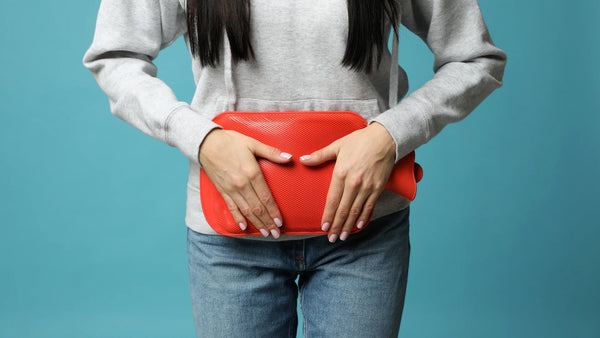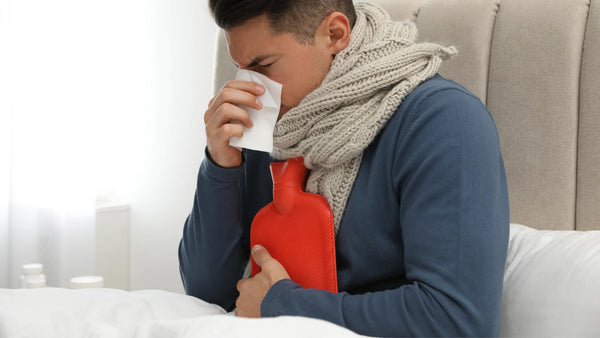Key Takeaways
- Risk of serious burns if the hot water bottle leaks or bursts with boiling water
- Water at 100°C is too hot for safe use of a water bottle
- Prefer a hot water temperature between 60 and 80°C for optimal comfort
Understand the importance of temperature when using a hot water bottle
The risks of burns linked to too high a temperature
Although its name may be confusing, it is strongly recommended not to fill a hot water bottle with boiling water at 100°C. At this extreme temperature, the risk of serious burns in the event of a leak or burst is very high. Many domestic accidents involving second or third degree burns are caused by improper use of hot water bottles.
The influence of temperature on comfort of use
Beyond the risk of burns, water that is too hot in the hot water bottle can also harm comfort of use. Excessive heat will make the hot water bottle difficult to handle and hold for a prolonged period. It is therefore preferable to opt for a water temperature allowing gentle and comforting heat.
How to determine the ideal temperature for a hot water bottle
Most manufacturers recommend a temperature of hot water between 60 and 80°C to fill a hot water bottle. This range helps avoid the risk of burns while providing a level of heat sufficient for well-being and relief pain. The ideal temperature may vary depending on your personal sensitivity and intended use.

Also read: Which hot water bottle lasts the longest ?
Hot water bottle materials and their heat resistance
Rubber and its reaction to boiling water
Many hot water bottles are made of natural or synthetic rubber. This material offers good flexibility and appreciable durability. However, rubber has limited resistance to heat. Prolonged or repeated exposure to boiling water may cause premature degradation of rubber and may cause cracks or leaks.
Other materials commonly used in hot water bottles
Other materials such as plastic, silicone or even certain composites are also used for the manufacture of hot water bottles. Their resistance to heat varies, but overall it is recommended to avoid direct and prolonged contact with boiling water to preserve their integrity.
As a textile specialist, I can assure you that the choice of materials is crucial for the durability and safety of a hot water bottle. Natural rubber offers excellent flexibility, but its heat resistance remains limited. This is why we favor materials such as silicone or certain technical composites for our high-end models.
— Geoffrey, Founder of The Oversized Hoodie®
Also read: How to use a rubber hot water bottle safely ?
The process of filling a hot water bottle
How to correctly fill a hot water bottle
To correctly fill your water bottle, follow these steps:
- Check that the hot water bottle is in good condition and has no cracks or leaks.
- Heat water to an appropriate temperature, usually between 60°C and 80°C for adults.
- Hold the hot water bottle vertically and unscrew the cap.
- Slowly fill it two-thirds full with hot water, leaving space for residual air.
- Press lightly on the sides to release excess air.
- Rescrew the cap firmly, without forcing too much so as not to damage the seal.
- Invert the hot water bottle to check for leaks before use.
Precautions to take when filling
Although practical, filling a hot water bottle requires some precautions:
- Wear insulated gloves to protect yourself from hot water.
- Work on a flat, stable surface to avoid spills.
- Keep children and pets away during the process.
- Make sure the cap is securely closed before handling the filled hot water bottle.
- Never fill the hot water bottle completely, always leave some space for the hot air to expand.
By following these instructions, you will be able to enjoy the benefits of your hot water bottle in complete safety.

Also read: What are the dangers of a hot water bottle on the stomach ?
Optimal use of a hot water bottle: instructions for use
How to heat a hot water bottle safely
To heat your hot water bottle safely, follow these steps:
- Heat water in a saucepan or kettle until it reaches a temperature between 60 and 80°C.
- Carefully pour this hot water into the hot water bottle, leaving space for expansion.
- You can also place the already filled hot water bottle in a pan of hot water for 10 minutes.
- Absolutely avoid filling the hot water bottle directly with boiling water at 100°C.
Years of experience have taught me that you should never neglect the instructions for use, even for a product as simple as a hot water bottle. At The Oversized Hoodie®, we pride ourselves on providing clear instructions for safe use and optimal comfort.
— Geoffrey, Founder of The Oversized Hoodie®
Also read: How a Pocket Hot Water Bottle Works ?
How to use a hot water bottle safely
Once the hot water bottle is heated, here are the best practices for safe use:
- Never leave the hot water bottle in direct contact with the skin, place a cloth or clothing between the two.
- Do not keep the hot water bottle in the same place for more than 30 minutes to avoid burns.
- Never fall asleep with a hot water bottle on, remove it from the bed before going to bed.
- For children and the elderly, reduce the temperature to 40-50°C maximum.
Also read: Hot water bottle on the stomach and constipation
Hot water bottle and microwave: what you need to know
Can you heat a hot water bottle in the microwave ?
It is not recommended to heat a traditional water bottle in the microwave, because materials such as rubber are not suitable. However, some specific models of dry hot water bottles filled with seeds are safe to microwave.
The potential dangers of using the microwave with a hot water bottle
Heating a classic hot water bottle in the microwave presents several risks:
- Localized overheating which may cause burns
- Premature degradation of materials such as rubber
- Possibility of explosion if the hot water bottle is not designed for the microwave
It is therefore essential to read the manufacturer's instructions before using in the microwave.

Also read: Hot water bottle or electric blanket ?
Very hot hot water bottle: how to achieve this without boiling water ?
Tips for having a hot water bottle without boiling water
Here are some tips for obtaining optimal heat without risking burns:
- Use a kettle with temperature setting to heat the water between 60 and 80°C.
- Heat the hot water bottle in a pan of very hot water for 10-15 minutes.
- Opt for a dry hot water bottle with seeds that you can heat regularly in the microwave.
- Wrap the hot water bottle in a blanket to better retain heat.
Alternatives to boiling water to heat a hot water bottle
Instead of boiling water, you can use:
- very hot water between 60 and 80°C
- A bottle warmer to precisely adjust the temperature
- An insulated kettle which keeps the water at the right heat
- A dry hot water bottle with seeds heated for a few minutes in the microwave
Also read: How long does a hot water bottle last ?
How a hot water bottle works: the basics to know
How a classic hot water bottle works
A classic hot water bottle is a waterproof bag made of rubber or plastic that is filled with hot water. This water transmits its heat by conduction through the flexible walls of the hot water bottle. The heat then diffuses slowly and sustainably over the application area.
The different types of hot water bottles and their mode of operation
There are several variations of hot water bottles:
- Water hot water bottle: Described above, this is the traditional model.
- Dry hot water bottle: Filled with seeds which store the heat from the microwave.
- Electric hot water bottle: Equipped with an electric resistance, it heats without water.
- Chemical hot water bottle: Chemical reaction producing heat in a controlled manner.
Each type has its advantages and particularities of use to know well.
Also read: How to keep a hot water bottle hot for a long time ?
Conclusion
To enjoy the benefits of a hot water bottle in complete safety, it is essential to choose the temperature of the water or filling. Excessive heat indeed presents risks of burns serious. By following good practices, this accessory remains an excellent natural and economical way to warm up or relieve pain.
| Appearance | Advice | Ideal Temperature | Materials |
|---|---|---|---|
| Risk of burns | Avoid water at 100°C | 60°C to 80°C | Rubber, Plastic, Silicone |
| Comfort of use | Opt for gentle heat | 60°C to 80°C | Varies depending on material |
| Secure fill | Use hot water, not boiling | 60°C to 80°C | Rubber, Plastic, Silicone |
| Filling precautions | Wear gloves, check for leaks | 60°C to 80°C | Varies depending on material |
| Safe to use | Do not apply directly to the skin | 40°C to 50°C for children and the elderly | Rubber, Plastic, Silicone |
| Microwave alternatives | Use dry microwave hot water bottles | N/A | Seeds, Specific Composites |
FAQ
How to heat a rubber hot water bottle ?
For a rubber hot water bottle, heat water to between 60 and 80°C in a saucepan or adjustable kettle. Pour it carefully into the hot water bottle, leaving space for expansion. You can also heat it in a pan of very hot water for 10-15 minutes.
How to have a very hot hot water bottle ?
For optimal heat without risk, use water between 60 and 80°C maximum. You can also opt for a dry hot water bottle with seeds that you reheat regularly in the microwave for short periods. Wrap the hot water bottle in a thick blanket to better retain heat.
How to boil a hot water bottle ?
It is strongly not recommended to fill a classic hot water bottle with boiling water at 100°C, at the risk of serious burns in the event of a leak or bursting. Prefer very hot water between 60 and 80°C maximum.
What water temperature for a hot water bottle ?
The temperature ideal for filling a hot water bottle is between 60 and 80°C for an adult. For children and the elderly, do not exceed 40 to 50°C to avoid any risk of burns.
How to use a hot water bottle ?
After filling it with very hot water, place a cloth between the hot water bottle and your skin to avoid burns. Do not keep it in one place for more than 30 minutes. Remove it from your bed before you go to sleep.
Can you put a rubber hot water bottle in the microwave ?
No, it is not recommended to microwave a traditional rubber hot water bottle, as this material is not suitable and could be damaged or explode under the effect of microwaves.
Can you put a hot water bottle in the microwave ?
Yes, but only dry hot water bottles specifically designed to be heated for a few minutes in the microwave. Conventional rubber or plastic water bottles should not be microwaved.
Updated March 25, 2024







